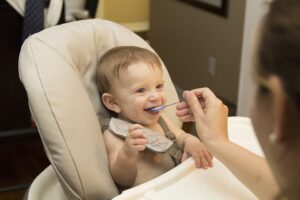ABAI Presidential Scholar Essay Contest:
Nadine Burke Harris

Photo by Michael Winokur
By Rachel L. Metras, Kara LaCroix, and Matthew J. Carbone
NOTE: Ms. Liz Neeley presented the 2021 Presidential Scholar Address on May 28 during the convention. Ms. Neeley graciously stepped in deliver the Presidential Scholar Address, which was vacated by Dr. Nadine Burke Harris, who had to cancel due to the ongoing COVID-19 pandemic and her role as California Surgeon General. We wish to acknowledge the winners of the ABAI Presidential Scholar Essay Contest, who wrote their essay before the change in speaker was made. We are deeply grateful to Ms. Neeley for providing a thought-provoking talk on science communication and sensemaking during crisis, and we hope to host Dr. Burke Harris at a future ABAI event.
Dr. Nadine Burke Harris is an award-winning physician, researcher, and advocate dedicated to changing the way society responds to one of the most serious, expensive, and widespread public health crises of our time: childhood trauma. She was appointed California’s first-ever Surgeon General by Governor Gavin Newsom in January 2019, and her career has been dedicated to serving vulnerable communities and combating the root causes of health disparities.
Her work has been profiled in best-selling books including How Children Succeed by Paul Tough and Hillbilly Elegy by J. D. Vance, as well as in Jamie Redford’s feature film Resilience. It has also been featured on NPR, CNN, and Fox News, and in USA Today and The New York Times. Dr. Burke Harris’s TED Talk, “How Childhood Trauma Affects Health Across a Lifetime,” has been viewed more than 7 million times. Her book The Deepest Well: Healing the Long-Term Effects of Childhood Adversity was called “indispensable” by The New York Times.
Reports by the Center for Youth Wellness (2017) show that 34.8 million children in the United States experience toxic stress or Adverse Childhood Experiences (ACEs; i.e., traumatic events) before they turn 17. This is concerning because children with high numbers of ACEs are 32.6 times more likely to have learning or behavioral disorders (Burke et al., 2011) and as adults, they are more prone to chronic health issues (e.g., sleep disturbances, depression) than their peers without ACEs (Felitti et al., 1998). Although there are behavioral treatments for children displaying signs of high ACE levels in schools (e.g., hyperactivity) and medical treatments for those same individuals as adults, behavioral and medical services are often disconnected from one another. In practice, this means that children with high ACE scores may not receive medical attention for their ACEs beyond being referred out to mental health services by their primary care physician, and children displaying behavioral problems may not always receive complementary medical services (Burke Harris, 2015).
To overcome this disparity, Nadine Burke Harris, the first Surgeon General of the State of California, has advocated for the treatment of toxic stress and ACEs through individualized, multi-disciplinary intervention teams for children. These intervention teams treat both behavioral and biological symptoms as a function of the child’s environment, which allows the team to address current behavioral challenges and future health concerns using the same comprehensive treatment method. The intervention team works together to develop treatment plans designed to prevent and mitigate the current and future effects of toxic stress. The treatment plans apply evidence-based interventions across a variety of domains that influence children, including child and family psychological needs, sleep health, nutritional deficits, educational progress, and physical activity (Burke Harris, 2019).
Burke Harris’s treatment model was successfully applied in clinical settings in California and New England (Bhushan et al., 2020), but ACEs are still prevalent throughout the United States. There is a clear need for dissemination of intervention strategies that will produce these same outcomes and prevent the development of ACEs. Due the similarities between Burke Harris’s approach and behavior analytic practice, behavior analysts may be uniquely poised to contribute to this intervention effort by creating programs that teach children to engage in healthful behaviors under target environmental conditions. However, there are also many implications of Burke Harris’s work that apply to behavior analytic practice. Two of these implications are described below.
One implication of Burke Harris’s work is that children may benefit more from one coordinated, multi-disciplinary intervention effort than many isolated intervention teams. In other words, although both psychological and medical interventions contribute to the wellbeing of a child with high ACEs, the best treatment outcomes can only be achieved when care is integrated. With an integrated care system, the same healthful behaviors, such as exercise, are goals that all members of the intervention team strive to achieve. This allows repeated practice opportunities for the same skills across different settings. Similar to behavior analytic practice, a client’s newly learned skill cannot be expected to maintain or transfer to new contexts if instruction is limited to one setting. Young children might not learn to enjoy exercising outside, for example, if expectations to do so differ across that child’s home, school, and afterschool settings.
Behavior analysts will likely benefit from this same collaborative approach when working with their own clients. Regardless of a client’s previous experience with toxic stress or ACEs, collaborating with other service providers to provide consistent learning opportunities across settings will only help client skills maintain and transfer across a variety of contexts. These outcomes may be especially relevant to behavior analysts working in schools, group homes, or early intervention settings, as they are often teaching their clients to interact with several different aspects of their communities. Consulting with community members when designing behavior intervention programs may give behavior analysts new insights on which skills will produce the broadest benefits for their clients. For example, when providing services to a child with a family history of heart disease, consulting with a doctor may reveal that it is more beneficial to spend 20 minutes a day teaching that child to enjoy different forms of cardiovascular exercise than practicing academic skills, because teaching the child to enjoy exercising will reduce long-term health risks and condition additional reinforcers.
Another implication of Burke Harris’s work is that children with high ACE scores may be more sensitive to certain types of reinforcers than others. Escape from work, for example, may be a particularly potent reinforcer because children with high ACE scores have more frequent activation of their fight-flight-or-freeze responses than children with low or no ACEs (Bhushan et al., 2020). For these children, stimuli associated with the everyday experiences of speaking in front of the class or trying to overcome a new challenge may activate their fight-flight-or-freeze response and enhance the value of escape. Once their fight-flight-or-freeze response is active, children may engage in challenging behaviors to avoid being in the circumstance that elicited that biological response.
If a child’s trauma history can change their susceptibility to particular reinforcers, behavior analysts may be interested in assessing ACEs prior to writing interventions for challenging behavior. Children with high ACE scores may need additional instruction aimed at increasing their tolerance of delays to reinforcement because their fight-flight-or-freeze response may be more active than children without low ACE scores. Clients with high ACE scores may also benefit from instruction that is provided in small achievable steps and from being able to make choices about how they learn. Programming these additional sources of reinforcement into intervention plans may contribute to create teaching contexts that motivate children to work through new challenges.
Toxic stress and ACEs are a public health issue that impact learning and wellness over the lifetime. Burke Harris’s recent work illustrates that multidisciplinary intervention teams can be mobilized to create positive outcomes in the lives of children. These same techniques can be leveraged by behavior analysts to create long lasting changes in our clients’ lives regardless of their ACE levels.
References
Association for Behavior Analysis International (2021). Presidential scholar. https://www.abainternational.org/events/annual/annual2021/presidential-scholar.aspx
Bhushan, D., Kotz, K., McCall, J., Wirtz, S., Gilgoff, R., Dube, S.R., Powers, C., Olson-Morgan,
J., Galeste, M., Patterson, K., Harris, L., Mills, A., Bethell, C., Burke Harris, N. (2020). Roadmap for resilience: The California surgeon general’s report on adverse childhood experiences, toxic stress, and health. Office of the California Surgeon General. https://osg.ca.gov/wp-content/uploads/sites/266/2020/12/Roadmap-For-Resilience_CA-Surgeon-Generals-Report-on-ACEs-Toxic-Stress-and-Health_12092020.pdf
Burke Harris, N. (2019). The deepest well: Healing the long-term effects of childhood adversity. Houghton Mifflin Harcourt Publishing Company.
Burke Harris, N. (2015). How childhood trauma affects health across a lifetime [Video]. TED Conferences. https://www.ted.com/talks/nadine_burke_harris_how_childhood_trauma_affects_health_across_a_lifetime
Burke, N. J., Hellman, J. L., Scott, B. G., Weems, C. F., & Carrion, V. G. (2011). The impact of adverse childhood experiences on an urban pediatric population. Child Abuse & Neglect, 35(6), 408-413.
Center for Youth Wellness (2017). Childhood adversity increases risk for long-term health and behavioral issues. https://centerforyouthwellness.org/health-impacts/
Felitti, V. J., Anda, R. F., Nordenberg, D., Williamson, D. F., Spitz, A. M., Edwards, V., & Marks, J. S. (1998). Relationship of childhood abuse and household dysfunction to many of the leading causes of death in adults: The adverse childhood experiences (ACE) study. American Journal of Preventive Medicine, 14(4), 245-258.
Waters, R. (2019, May 23). California surgeon general puts spotlight on childhood trauma. California Healthcare Foundation. https://www.chcf.org/blog/california-surgeon-general-puts-spotlight-on-childhood-trauma/


